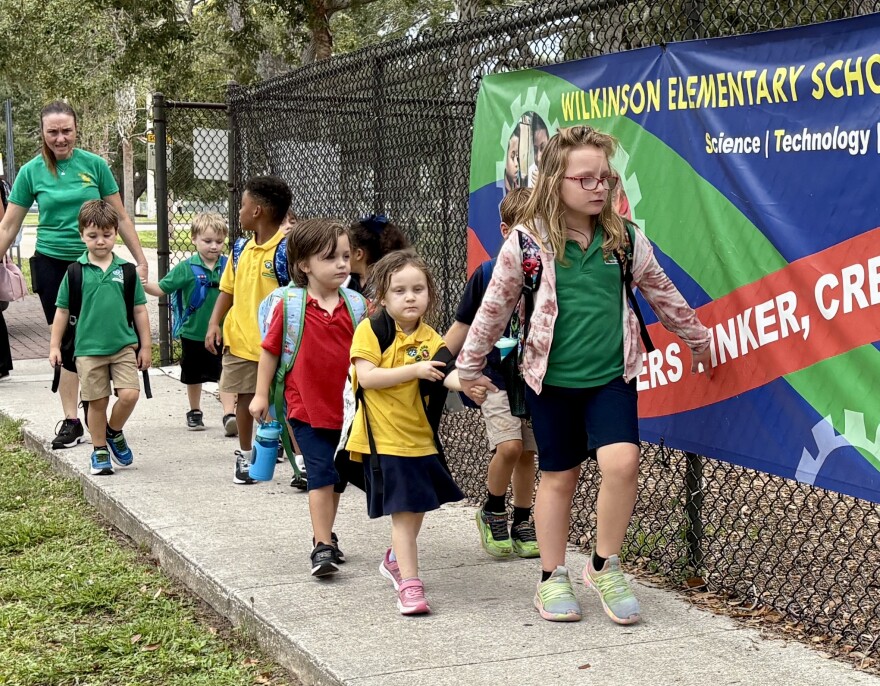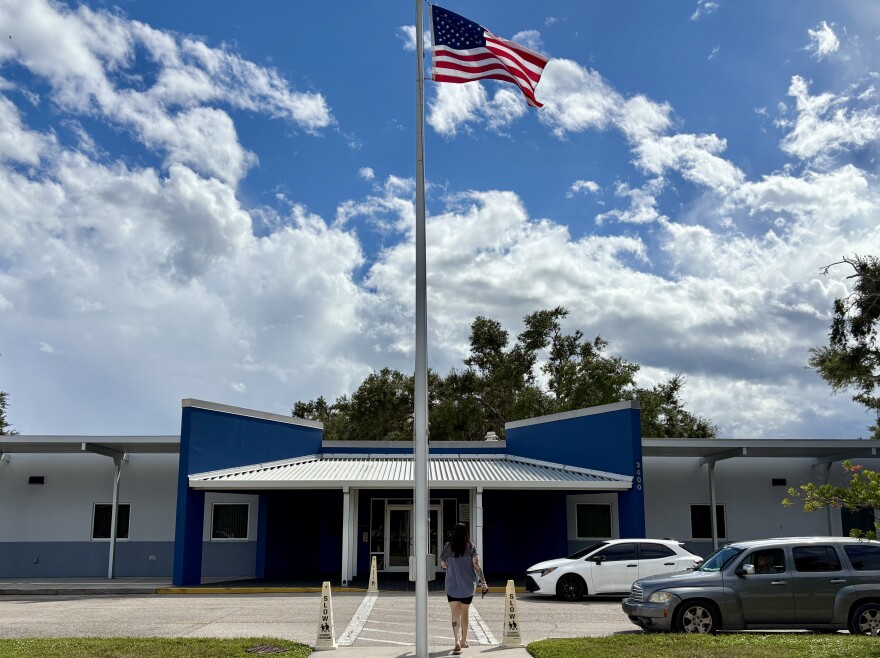Florida’s new charter-school law promised to open more classrooms for kids. In Sarasota County, where enrollment has stalled and desks are supposedly sitting empty, it could just end up spreading school resources even thinner.
Gov. Ron DeSantis has hailed the new “Schools of Hope” measure as a way to help students “failed by the system,” giving charter operators access to public-school space they say is going to waste.
But a Suncoast Searchlight analysis of district and census data shows Sarasota’s situation is far more complex: Local charter schools have nearly the same percentage of underused space as traditional campuses, and the district’s vacancy rates — measured through a metric known as utilization — are less about failure than Florida’s demographics.
Sarasota is hardly a struggling system. The district has maintained an A rating from the state for more than a decade, buoyed by an older, wealthier tax base and a relatively small school-age population. Yet those same demographics now leave Sarasota with more classroom space than children to fill them.
District data show Sarasota’s public schools operate at a median 82% utilization, nearly identical to the 84% rate at the county’s 14 charter schools. Some of the lowest-performing charters are barely a third full, the data show.
With few new families moving in and one of the lowest birth rates in Florida, there simply aren’t enough children to occupy all the seats already available.
“Sarasota’s affordable housing shortage has contributed to fewer young families moving here — and in fact many leaving — meaning there are fewer children to attend schools overall, not that there is any kind of large exodus from public schools,” said Holly Bullard, chief strategy and development officer with the Florida Policy Institute, said in a statement to Suncoast Searchlight.
Bullard’s child attends Wilkinson Elementary, one of the district’s under-utilized schools. Wilkinson was initially eyed for closure to prevent a Schools of Hope takeover. That plan has since been shelved, but other campuses remain in question after Miami-based Mater Academy Inc., one of Florida’s largest charter operators, filed notices this month to occupy dozens of public-school campuses across the state.
Three of those schools are in Sarasota County: Emma E. Booker, Brookside Middle, and Oak Park School, a K–12 campus serving students with disabilities. They have among the county’s highest vacancy rates, each operating below 60% capacity.
Yet the “unused space” driving the new law isn’t always what it seems. Rather than leaving classrooms empty, schools are repurposing them as art rooms, computer labs or small-group learning areas.
“We never had any empty classrooms,” said Melodie Deeds, a former assistant principal at Wilkinson who retired from the district two years ago.
With nearly 7,500 vacant student stations countywide, though, the district is scrambling to readjust utilization and ward off more takeover attempts. Officials have held parent meetings for eight schools with the lowest enrollments, weighing options that range from adding middle-school grades at Brentwood, Alta Vista and Gulf Gate elementaries to leasing extra space at Booker Middle to a childcare provider.
District leaders have also appealed to the Florida Department of Education, which recently toured Sarasota campuses and, according to multiple sources, agreed to lower the number of “available” seats that could be claimed by charter operators. School Board Member Tom Edwards said the department plans to reclassify space as unavailable for Schools of Hope.
But neither Edwards nor other officials would discuss details until a school-board workshop on Tuesday, when Superintendent Terry Connor is expected to outline next steps.
“We all are holding our breath until it’s final,” said School Board Member Liz Barker.
No mass departure from public education
Charter schools in Sarasota County have been around since at least 1997 when the Sarasota School of Arts & Sciences opened its doors. The number of charter schools has grown in recent years, but the share of students at charters has not shifted much.
In the 2020–21 school year, about 86% of Sarasota County students attended traditional public schools, while the remaining 14% were enrolled in charters, according to district figures that did not include homeschool or private school students. Since then, charter enrollment has crept up only slightly — to about 16% — and district forecasts show that share holding steady through the end of the decade.
Some of the emptiest schools aren’t district-run at all but charters themselves. Innovation Academy SRQ fills fewer than one in five available seats, and Imagine School at Palmer Ranch runs at just over half capacity. The pattern, experts say, points to a system with more classroom space than children — not a mass departure from public education.
“In Sarasota, the public schools are still outperforming the charter schools,” Edwards said. “At the end of the day, people are returning to public education after they’ve left.”
But while district spreadsheets capture countywide trends, educators say they rarely reflect the reality inside classrooms. At Wilkinson, for instance, rooms labeled “underutilized” on paper were in constant use, Deeds said.

Deeds, who also spent two years on the district’s charter review committee, which reviews traditional charter schools before allowing them to open, said she warned administrators years ago that unchecked charter growth could erode enrollment long before the new Schools of Hope law appeared. But she said district leaders never discussed utilization or capacity issues with teachers.
“We just went to work and did whatever it took to educate our students,” she said.
Her experience underscores what district officials began to tackle this month: not failing schools, but uneven ones — a reflection of the county’s shifting demographics rather than parental discontent.
An age-old tale of Sarasota’s demographics
Sarasota’s birth rate ranks seventh-lowest in Florida — on par with retirement havens like Charlotte and Sumter counties — but with more than twice their population, the imbalance between growth and childbearing is far greater, state health data show.
That means fewer children in the school system than what one would expect for a community of this size.
Nearly half a million people live in Sarasota County, yet only about 48,000 were school-aged in 2023, the latest figures available using five-year American Community Survey data from the U.S. Census Bureau.
Over the past decade, the county’s total population has soared while the number of children has barely grown, leaving enrollment stagnant even as the community around these schools expands.
“This is just a feature of having a relatively larger percentage of older adults compared to Florida overall,” Bullard said. “Only 14% of Sarasota County’s population is under age 18, compared to 19% statewide.”
The imbalance isn’t evenly spread. Growth has pushed east and south — toward areas like Lakewood Ranch, Wellen Park and North Port — where new families are, in fact, moving. Schools such as Tatum Ridge Elementary, Lamarque Elementary and Atwater Elementary have filled up quickly, while older campuses closer to Sarasota’s urban core have lost students, sometimes by the hundreds.
The middle school dropoff
Among the area campuses bleeding the most enrollment are middle schools.
McIntosh, Brookside and Woodland middle schools each saw student enrollment fall by more than 10% during the past decade. And all but two county middle schools — Sarasota Middle and Venice Middle — currently have more than 400 seats of available capacity that a Schools of Hope charter operator could take.
Officials point to middle school as a challenging time for students with parents hesitant to send their children to the district’s large middle school campuses. Middle school enrollment is about half of the district’s high school enrollment, with the district losing students to the smaller, more intimate charter schools before then returning to a public high school.

To combat the trend, the district plans to add middle school classes to many of its underutilized elementary schools, including Wilkinson, Alta Vista, Brentwood and Gulfgate.
Damaris Allen, executive director at Families for Strong Public Schools, said the plan could help the district keep more kids in neighborhood schools.
She pointed to Hillsborough County, where Carrollwood Elementary added middle school classes. The result was enrollment increased and fewer children left for charters or private schooling.
Still, Allen said the district spending all this time reacting to the legislation isn’t a good thing, even if it results in rapid changes.
“What’s frustrating to me is this isn’t the best use of district resources,” she said. “My hope is they repeal this legislation because it’s not good for anyone.”
She was not surprised to see the charter schools have the same utilization issues as public schools.
“This legislation wasn’t created to solve a problem,” Allen said. “It has created a problem because they are taking funds from public schools, and they are going to take existing opportunities from current students.”
Utilization versus capacity and why it matters
John W. Diamond, senior director of the Center for Tax and Budget Policy at Rice University’s Baker Institute for Public Policy, said that on its face, Sarasota County Public Schools looks like it has an excellent overall utilization rate.
But dig deeper — and it’s an uneven spread.
There are more than a dozen public schools with under a 70% utilization rate, while at least 10 schools exceed their maximum capacities.
Capacity looks at how many seats are available, while utilization looks at the usage. In other words, it is the intended usage of a school and then the actual usage of it.
Diamond, who authored a research study about enrollment trends in Houston’s Independent School District earlier this year, said Sarasota is facing a similar problem to the fourth largest city in the United States — there are too many students in many of the schools.
He said overcrowding schools not only presents obstacles for over-utilization, but the wear and tear on the facilities is also accelerated.
While Diamond said there are clear unfair disparities with the Schools of Hope law — like not having charters pay any utility cost if they co-locate inside a public school — he said it could help the county’s utilization rate.
School districts across the country, particularly in urban areas, have long faced declining enrollment rates. For example, Chicago’s public school system has lost 100,000 students since 2000 — approximately 25% of its enrollment — resulting in a third of its campuses operating at less than half capacity, according to the Brookings Institute study.
Declining enrollment was further exacerbated by the pandemic, when schools lost 1.2 million students, according to the National Center for Education Statistics. By 2031-32, the agency projects a further enrollment decline of 2.7 million students.
“There is a utilization problem in Sarasota,” Diamond said. “The question is what do you do about that?”
Derek Gilliam is an investigative/watchdog reporter, Josh Salman is a senior investigative reporter/deputy editor and McKenna Oxenden is a government watchdog reporter at Suncoast Searchlight. Reach out to them at derek@suncoastsearchlight.org, josh@suncoastsearchlight.org or mckenna@suncoastsearchlight.org.
This story was produced by Suncoast Searchlight, a nonprofit newsroom of the Community News Collaborative serving Sarasota, Manatee and DeSoto counties. Learn more at suncoastsearchlight.org.



